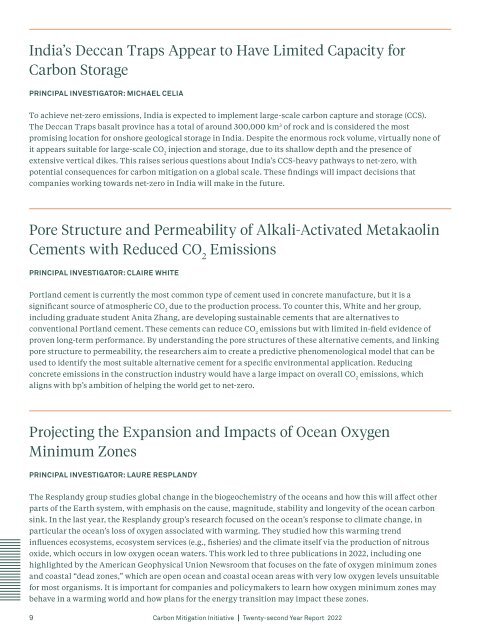CMI Annual Report 2022
Create successful ePaper yourself
Turn your PDF publications into a flip-book with our unique Google optimized e-Paper software.
India’s Deccan Traps Appear to Have Limited Capacity for<br />
Carbon Storage<br />
PRINCIPAL INVESTIGATOR: MICHAEL CELIA<br />
To achieve net-zero emissions, India is expected to implement large-scale carbon capture and storage (CCS).<br />
The Deccan Traps basalt province has a total of around 300,000 km 3 of rock and is considered the most<br />
promising location for onshore geological storage in India. Despite the enormous rock volume, virtually none of<br />
it appears suitable for large-scale CO 2<br />
injection and storage, due to its shallow depth and the presence of<br />
extensive vertical dikes. This raises serious questions about India’s CCS-heavy pathways to net-zero, with<br />
potential consequences for carbon mitigation on a global scale. These findings will impact decisions that<br />
companies working towards net-zero in India will make in the future.<br />
Pore Structure and Permeability of Alkali-Activated Metakaolin<br />
Cements with Reduced CO 2<br />
Emissions<br />
PRINCIPAL INVESTIGATOR: CLAIRE WHITE<br />
Portland cement is currently the most common type of cement used in concrete manufacture, but it is a<br />
significant source of atmospheric CO 2<br />
due to the production process. To counter this, White and her group,<br />
including graduate student Anita Zhang, are developing sustainable cements that are alternatives to<br />
conventional Portland cement. These cements can reduce CO 2<br />
emissions but with limited in-field evidence of<br />
proven long-term performance. By understanding the pore structures of these alternative cements, and linking<br />
pore structure to permeability, the researchers aim to create a predictive phenomenological model that can be<br />
used to identify the most suitable alternative cement for a specific environmental application. Reducing<br />
concrete emissions in the construction industry would have a large impact on overall CO 2<br />
emissions, which<br />
aligns with bp’s ambition of helping the world get to net-zero.<br />
Projecting the Expansion and Impacts of Ocean Oxygen<br />
Minimum Zones<br />
PRINCIPAL INVESTIGATOR: LAURE RESPLANDY<br />
The Resplandy group studies global change in the biogeochemistry of the oceans and how this will affect other<br />
parts of the Earth system, with emphasis on the cause, magnitude, stability and longevity of the ocean carbon<br />
sink. In the last year, the Resplandy group’s research focused on the ocean’s response to climate change, in<br />
particular the ocean’s loss of oxygen associated with warming. They studied how this warming trend<br />
influences ecosystems, ecosystem services (e.g., fisheries) and the climate itself via the production of nitrous<br />
oxide, which occurs in low oxygen ocean waters. This work led to three publications in <strong>2022</strong>, including one<br />
highlighted by the American Geophysical Union Newsroom that focuses on the fate of oxygen minimum zones<br />
and coastal “dead zones,” which are open ocean and coastal ocean areas with very low oxygen levels unsuitable<br />
for most organisms. It is important for companies and policymakers to learn how oxygen minimum zones may<br />
behave in a warming world and how plans for the energy transition may impact these zones.<br />
9<br />
Carbon Mitigation Initiative Twenty-second Year <strong>Report</strong> <strong>2022</strong>
















